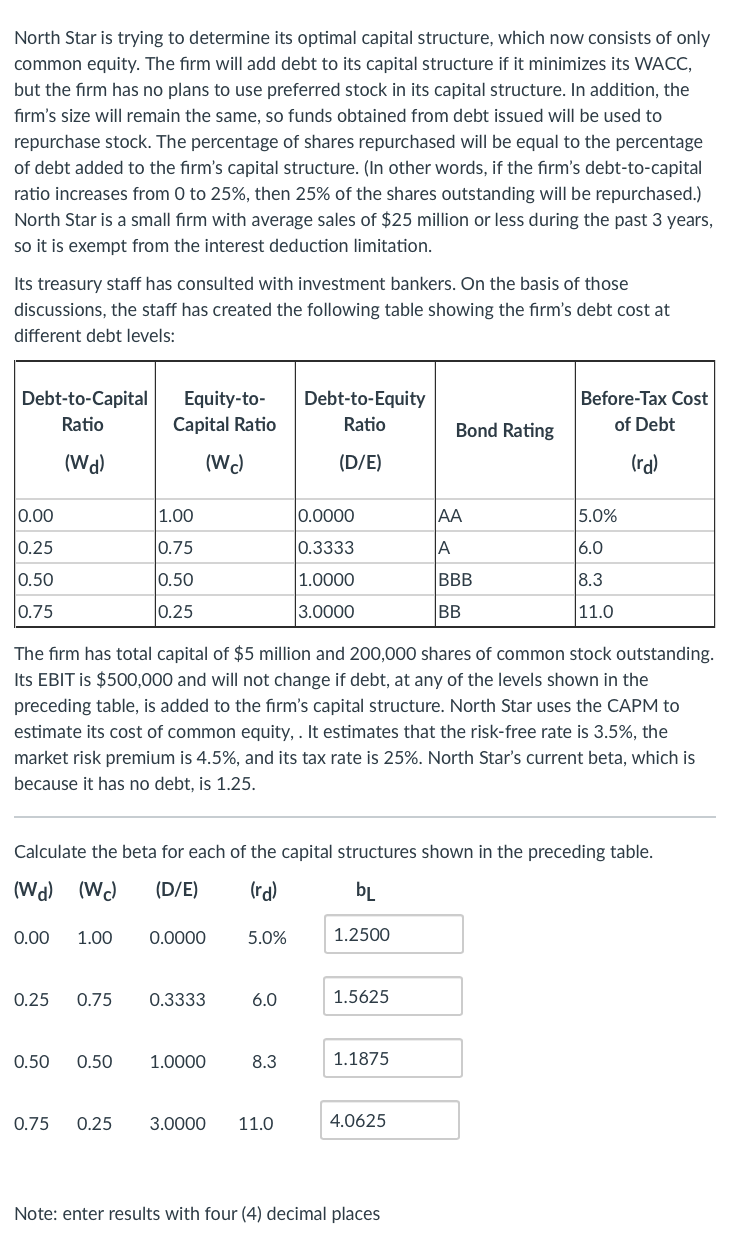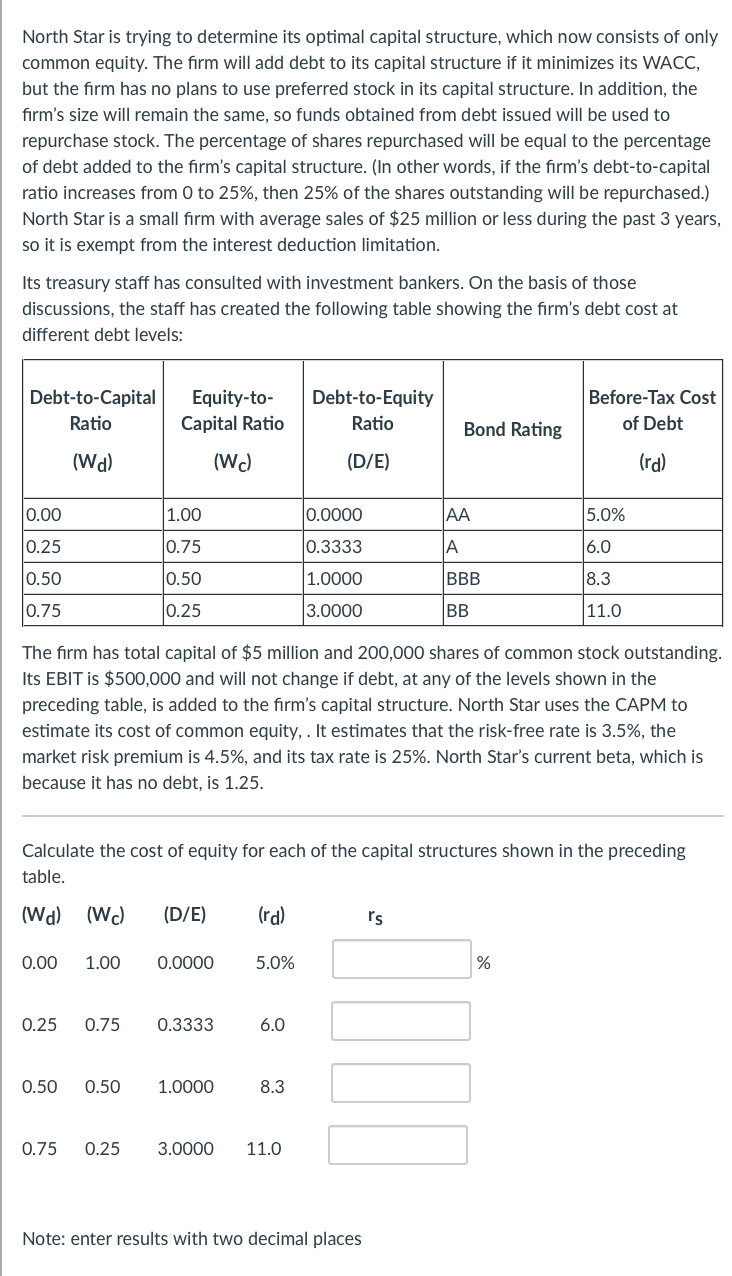North Star is trying to determine its optimal capital structure, which now consists of only common equity. The firm will add debt to its capital structure if it minimizes its WACC, but the firm has no plans to use preferred stock in its capital structure. In addition, the fırm's size will remain the same, so funds obtained from debt issued will be used to repurchase stock. The percentage of shares repurchased will be equal to the percentage of debt added to the firm's capital structure. (In other words, if the firm's debt-to-capital ratio increases from 0 to 25%, then 25% of the shares outstanding will be repurchased.) North Star is a small firm with average sales of $25 million or less during the past 3 years, so it is exempt from the interest deduction limitation. Its treasury staff has consulted with investment bankers. On the basis of those discussions, the staff has created the following table showing the firm's debt cost at different debt levels: Debt-to-Capital Equity-to- Debt-to-Equity Before-Tax Cost Ratio Capital Ratio Ratio Bond Rating of Debt (Wd) (W) (D/E) (ra) 0.00 1.00 0.0000 AA 5.0% 0.25 0.75 0.3333 A |6.0 0.50 0.50 |1.0000 BBB 8.3 0.75 0.25 3.0000 BB 11.0 The firm has total capital of $5 million and 200,000 shares of common stock outstanding. Its EBIT is $500,000 and will not change if debt, at any of the levels shown in the preceding table, is added to the firm's capital structure. North Star uses the CAPM to estimate its cost of common equity, . It estimates that the risk-free rate is 3.5%, the market risk premium is 4.5%, and its tax rate is 25%. North Star's current beta, which is because it has no debt, is 1.25. Calculate the beta for each of the capital structures shown in the preceding table. (Wa) (W) (D/E) (rd) bL 0.00 1.00 0.0000 5.0% 1.2500 0.25 0.75 0.3333 6.0 1.5625 0.50 0.50 1.0000 8.3 1.1875 0.75 0.25 3.0000 11.0 4.0625 Note: enter results with four (4) decimal places
North Star is trying to determine its optimal capital structure, which now consists of only common equity. The firm will add debt to its capital structure if it minimizes its WACC, but the firm has no plans to use preferred stock in its capital structure. In addition, the fırm's size will remain the same, so funds obtained from debt issued will be used to repurchase stock. The percentage of shares repurchased will be equal to the percentage of debt added to the firm's capital structure. (In other words, if the firm's debt-to-capital ratio increases from 0 to 25%, then 25% of the shares outstanding will be repurchased.) North Star is a small firm with average sales of $25 million or less during the past 3 years, so it is exempt from the interest deduction limitation. Its treasury staff has consulted with investment bankers. On the basis of those discussions, the staff has created the following table showing the firm's debt cost at different debt levels: Debt-to-Capital Equity-to- Debt-to-Equity Before-Tax Cost Ratio Capital Ratio Ratio Bond Rating of Debt (Wd) (W) (D/E) (ra) 0.00 1.00 0.0000 AA 5.0% 0.25 0.75 0.3333 A |6.0 0.50 0.50 |1.0000 BBB 8.3 0.75 0.25 3.0000 BB 11.0 The firm has total capital of $5 million and 200,000 shares of common stock outstanding. Its EBIT is $500,000 and will not change if debt, at any of the levels shown in the preceding table, is added to the firm's capital structure. North Star uses the CAPM to estimate its cost of common equity, . It estimates that the risk-free rate is 3.5%, the market risk premium is 4.5%, and its tax rate is 25%. North Star's current beta, which is because it has no debt, is 1.25. Calculate the beta for each of the capital structures shown in the preceding table. (Wa) (W) (D/E) (rd) bL 0.00 1.00 0.0000 5.0% 1.2500 0.25 0.75 0.3333 6.0 1.5625 0.50 0.50 1.0000 8.3 1.1875 0.75 0.25 3.0000 11.0 4.0625 Note: enter results with four (4) decimal places
Fundamentals Of Financial Management, Concise Edition (mindtap Course List)
10th Edition
ISBN:9781337902571
Author:Eugene F. Brigham, Joel F. Houston
Publisher:Eugene F. Brigham, Joel F. Houston
Chapter13: Capital Structure And Leverage
Section: Chapter Questions
Problem 14SP: WACC AND OPTIMAL CAPITAL STRUCTURE Elliott Athletics is trying to determine its optimal capital...
Related questions
Question

Transcribed Image Text:North Star is trying to determine its optimal capital structure, which now consists of only
common equity. The firm will add debt to its capital structure if it minimizes its WACC,
but the firm has no plans to use preferred stock in its capital structure. In addition, the
firm's size will remain the same, so funds obtained from debt issued will be used to
repurchase stock. The percentage of shares repurchased will be equal to the percentage
of debt added to the firm's capital structure. (In other words, if the firm's debt-to-capital
ratio increases from 0 to 25%, then 25% of the shares outstanding will be repurchased.)
North Star is a small firm with average sales of $25 million or less during the past 3 years,
so it is exempt from the interest deduction limitation.
Its treasury staff has consulted with investment bankers. On the basis of those
discussions, the staff has created the following table showing the firm's debt cost at
different debt levels:
Debt-to-Capital
Equity-to-
Debt-to-Equity
Before-Tax Cost
Ratio
Capital Ratio
Ratio
Bond Rating
of Debt
(Wa)
(W)
(D/E)
(ra)
0.00
|1.00
0.0000
AA
5.0%
0.25
0.75
0.3333
A
|6.0
0.50
0.50
1.0000
BBB
8.3
0.75
0.25
3.0000
BB
11.0
The firm has total capital of $5 million and 200,000 shares of common stock outstanding.
Its EBIT is $500,000 and will not change if debt, at any of the levels shown in the
preceding table, is added to the firm's capital structure. North Star uses the CAPM to
estimate its cost of common equity, . It estimates that the risk-free rate is 3.5%, the
market risk premium is 4.5%, and its tax rate is 25%. North Star's current beta, which is
because it has no debt, is 1.25.
Calculate the beta for each of the capital structures shown in the preceding table.
(Wa) (W)
(D/E)
(ra)
bL
0.00
1.00
0.0000
5.0%
1.2500
0.25
0.75
0.3333
6.0
1.5625
0.50
0.50
1.0000
8.3
1.1875
0.75
0.25
3.0000
11.0
4.0625
Note: enter results with four (4) decimal places

Transcribed Image Text:North Star is trying to determine its optimal capital structure, which now consists of only
common equity. The firm will add debt to its capital structure if it minimizes its WACC,
but the firm has no plans to use preferred stock in its capital structure. In addition, the
firm's size will remain the same, so funds obtained from debt issued will be used to
repurchase stock. The percentage of shares repurchased will be equal to the percentage
of debt added to the firm's capital structure. (In other words, if the firm's debt-to-capital
ratio increases from 0 to 25%, then 25% of the shares outstanding will be repurchased.)
North Star is a small fırm with average sales of $25 million or less during the past 3 years,
so it is exempt from the interest deduction limitation.
Its treasury staff has consulted with investment bankers. On the basis of those
discussions, the staff has created the following table showing the firm's debt cost at
different debt levels:
Debt-to-Capital
Equity-to-
Debt-to-Equity
Before-Tax Cost
Ratio
Capital Ratio
Ratio
Bond Rating
of Debt
(Wa)
(W)
(D/E)
0.00
1.00
0.0000
AA
5.0%
0.25
0.75
0.3333
A
6.0
0.50
0.50
1.0000
BBB
8.3
0.75
0.25
3.0000
BB
|11.0
The firm has total capital of $5 million and 200,000 shares of common stock outstanding.
Its EBIT is $500,000 and will not change if debt, at any of the levels shown in the
preceding table, is added to the firm's capital structure. North Star uses the CAPM to
estimate its cost of common equity, . It estimates that the risk-free rate is 3.5%, the
market risk premium is 4.5%, and its tax rate is 25%. North Star's current beta, which is
because it has no debt, is 1.25.
Calculate the cost of equity for each of the capital structures shown in the preceding
table.
(Wd) (W)
(D/E)
(rd)
's
0.00
1.00
0.0000
5.0%
%
0.25
0.75
0.3333
6.0
0.50
0.50
1.0000
8.3
0.75
0.25
3.0000
11.0
Note: enter results with two decimal places
Expert Solution
This question has been solved!
Explore an expertly crafted, step-by-step solution for a thorough understanding of key concepts.
This is a popular solution!
Trending now
This is a popular solution!
Step by step
Solved in 2 steps with 2 images

Knowledge Booster
Learn more about
Need a deep-dive on the concept behind this application? Look no further. Learn more about this topic, finance and related others by exploring similar questions and additional content below.Recommended textbooks for you

Fundamentals Of Financial Management, Concise Edi…
Finance
ISBN:
9781337902571
Author:
Eugene F. Brigham, Joel F. Houston
Publisher:
Cengage Learning


EBK CONTEMPORARY FINANCIAL MANAGEMENT
Finance
ISBN:
9781337514835
Author:
MOYER
Publisher:
CENGAGE LEARNING - CONSIGNMENT

Fundamentals Of Financial Management, Concise Edi…
Finance
ISBN:
9781337902571
Author:
Eugene F. Brigham, Joel F. Houston
Publisher:
Cengage Learning


EBK CONTEMPORARY FINANCIAL MANAGEMENT
Finance
ISBN:
9781337514835
Author:
MOYER
Publisher:
CENGAGE LEARNING - CONSIGNMENT

Intermediate Financial Management (MindTap Course…
Finance
ISBN:
9781337395083
Author:
Eugene F. Brigham, Phillip R. Daves
Publisher:
Cengage Learning


Financial Reporting, Financial Statement Analysis…
Finance
ISBN:
9781285190907
Author:
James M. Wahlen, Stephen P. Baginski, Mark Bradshaw
Publisher:
Cengage Learning